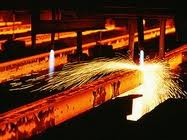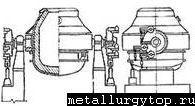Metallurgy - What is It?
 Metallurgy is the art and science that deals in extracting metals from their ores, alloying and getting the impurities of the metal and transform the metals to a more useful object. It is also the study of metals, its physical and chemical properties, the atomic structure and the process on how to combine to produce an alloy.
Metallurgy is the art and science that deals in extracting metals from their ores, alloying and getting the impurities of the metal and transform the metals to a more useful object. It is also the study of metals, its physical and chemical properties, the atomic structure and the process on how to combine to produce an alloy.
There are two phases to extract the metal from its ore; this includes mineral processing and process metallurgy. During the mineral processing, desired broken elements are extracted from the broken ore. The minerals are created to produce an alloy and metal to a more useful form during the metallurgy process.
Metallurgy is divided into two processes, the process metallurgy and the physical metallurgy. Process metallurgy includes the system metal processing while in physical metallurgy includes the mechanical behavior of the metals.
The process metallurgy uses the some method in chemical engineering in the construction of metals. There are two major steps in the production of metal. First is the production of a tainted metal from ore, and second is the refining of the metal.
Physical metallurgy is concerned with the scientific principle to the heat treatment, mechanical treatment, fabrication and service behavior of metals.
The process to extract the metal from the elements will depend upon the combination of the substance found in the ore and the elements of the metal to be remove. Since silver and gold is mercury soluble, mercury is used to extract silver and gold from other elements. The other way to extract the two compounds from other substance is by the treatment called cyanide process. To separate silver from lead elements, parkes process is being used. Chemical reactions are needed to separate metals from other elements
Electrometallurgy, hydrometallurgy and pyrometallurgy are the classification of chemical process. Electrometallurgy used electrolysis to separate other elements from metal. Hydrometallurgy also called as leaching, uses selective suspension. And pyrometallurgy, uses heat treatment solution.





Boric Acid
 Boric acid is made out of hydrogen (three parts), oxygen (three parts), and one part boron. Boron, like oxygen and hydrogen, occurs naturally in the water, air, and soil. Most people actually eat a small amount of boron every day without realizing it.
Boric acid is made out of hydrogen (three parts), oxygen (three parts), and one part boron. Boron, like oxygen and hydrogen, occurs naturally in the water, air, and soil. Most people actually eat a small amount of boron every day without realizing it.
Boric Acid Silly Putty
The most famous boric acid product is silly putty. It's a mixture of silicone oil and boric acid. It was developed by accident by James Wright (G.E. engineer).
Common Uses
Boric acid is used in a lot of ways. Here are some of the most common:
- – Pharmaceuticals
- – nutritional supplements
- –flame retardants
- –metallurgy
- –glass
- –wood preservative
- – flame retardants.
Roaches
Most people discover boric acid the first time they have a roach problem. It is the simplest and least toxic way to eliminate roaches. In a bait paste, it is the most effective way to eliminate roaches.
Where To Buy Boric Acid
Many big box retailers sell it as a dust for roaches. If you're really smart you can mix it with some silicone oil and make your own silly putty. Is silly putty is a good roach control method? In all seriousness, don't try to make your own silly putty.
Roach Bait
Bait is more effective at killing roaches than dust or powders. The roaches are attracted to bait and ingest a fair amount of boric acid with their meal. Then, they take the food back to the nest to finish off the colony. It only takes one application.





Silver Gemstone Jewelry History In Neolithic India
 In the majority of Neolithic India, as in most parts of the world at that time, people fashioned jewelry out of seeds, feathers, berries, flowers, bones and shells. But in the north of India, in the Indus valley cities of Mohenjo–daro and Harappan, men and women were already wearing jewelry made of gold, silver, copper and set with precious and semi–precious gemstones.
In the majority of Neolithic India, as in most parts of the world at that time, people fashioned jewelry out of seeds, feathers, berries, flowers, bones and shells. But in the north of India, in the Indus valley cities of Mohenjo–daro and Harappan, men and women were already wearing jewelry made of gold, silver, copper and set with precious and semi–precious gemstones.
The Indus valley civilization, preceding the Vedic, existed from 3000 B.C. to 1500 B.C., and was built in and amongst the fertile lands of what is known today as Pakistan. The Neolithic Indus valley people like others, domesticated animals and harvested crops of cotton, sesame and barley. Contrary to the belief that India only possessed an agricultural economy in this period, evidence has been found at the Indus cities of Mohenjo–daro and Harappan, showing the people as having been sophisticated urbanites whose cities were bastions to art and culture.
The brick cities, acting as focal points for a kind of centralized state, towered high above the Indus plains and were established along important trade routes that connected the 'Far East' with the 'Near East'. They were visible for large distances, a landmark to the prosperity of their rulers, inhabited by generations of merchant classes, skilled artisans, farmers and sea–faring adventurers engaged in extensive trading.
Proof of the Indus people's impact on Neolithic trade was found when archaeologists excavating Mohenjo–daro and Harappan found engraved seals written in cuneiform, the world's first written language whose origins lay in Mesopotamia in the Near East. The seals, describing the contents of sacks, were used to close bundles of merchandise as cord marks on the reverse side testify. Other similar seals were found in ports on the Persian Gulf near modern Bahrain, and amongst Mesopotamian sites at the city of Ur.
The seals originating from the Indus sites described cargos of textiles, and luxury goods such as semi precious gemstones, ivory, carnelian beads, pearls, mother of pearl and jade sent to Persia and Mesopotamia in exchange for gold, silver, tin, copper, lapis lazuli and turquoise. Bitumen from Mesopotamia, where it occured naturally, was also imported and used as the binding glue in mother of pearl inlay in precious items of jewelry and ornamentation. These products and their seals found in various Indus archeological sites bare testament to the presence of foreign traders living amongst the Indus people.
The Indus civilizations were ethnically diverse incorporating many cultures and creeds. Many terracotta, bronze and stone figurines found at the Indus sites display a variety of different styles of clothing, headdresses and ornamentation indicating a multi–ethnic civilization. Some of the figurines were adorned with multiple chokers and necklaces, which appear to represent beaded ornaments of gold, silver, and semi–precious gems. The complex 'Cire Perdue' casting technique, meaning 'Lost–wax,' was employed in the production of the metallic figures pointing towards a culture of knowledgeable and sophisticated metallurgists.
Further excavations of Mohenjo–daro's lower levels revealed the living quarters of metal workers, specializing in the production of copper and bronze implements and weapons. Flat axes, spears, knives, arrowheads, chisels, saws and razors were caste in smelting furnaces then simply hammered into shape. Silver, reserved for smaller precious objects, was smelted and molded into small vases, vessels, seals, pendants, and brooches. Other crafts in the city included the manufacturing of beads made in a variety of different shells, ivory and semi precious gem types such as alabaster, lapis lazuli and turquoise from Persia, amethyst from Maharashtra, and jade from Central Asia.
By 2000 B.C. the Indus valley civilizations were disappearing due to internal decline. The eventual demise of the Indus Valley Civilization came about in 1500 B.C., with Aryan invaders from the north firstly destroying the outlying villages, and then overrunning the cities of Harappan and Mohenjo–daro. The Indus civilization with their highly advanced knowledge of process metallurgy, gem cutting and jewelry production were eventually pushed further south into India where they created a legacy of fine arts for which India today is known the world over. By the third century B.C., after the reign of Buddhist emperor Ashoka, India was mining its own extensive gemstone resources, and had become the world's leading exporter of precious and semi–precious gemstones.
Copyright © SilverShake Corporation. All Rights Reserved.




